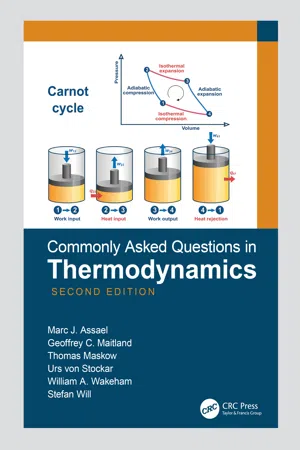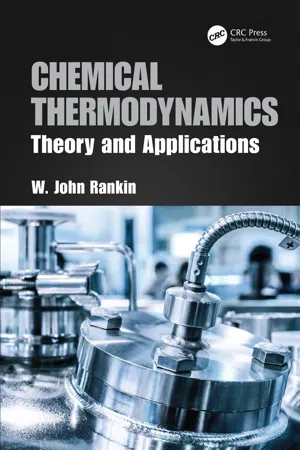Technology & Engineering
Moles in Thermodynamics
In thermodynamics, a mole is a unit of measurement used to express the amount of a substance. It represents a specific number of particles, which is approximately 6.02 x 10^23. Moles are important in thermodynamics because they allow for the calculation of various properties of a substance, such as its mass and volume.
Written by Perlego with AI-assistance
Related key terms
Related key terms
1 of 4
Related key terms
1 of 3
3 Key excerpts on "Moles in Thermodynamics"
- eBook - ePub
- Marc J. Assael, Geoffrey C. Maitland, Thomas Maskow, Urs von Stockar, William A. Wakeham, Stefan Will(Authors)
- 2022(Publication Date)
- CRC Press(Publisher)
f that relates the two sets of variablesf ((1.3)Γ A,Γ B) = 0 .For three systems, A, B and C, that are all adiabatically enclosed, if A is in thermal equilibrium with B which is also in equilibrium with C then A must be in thermal equilibrium with C. This is often referred to as the Zeroth law of thermodynamics. This of course assumes that sufficient time has elapsed to permit attainment of internal thermal equilibrium.1.3.10 What Is the Amount of Substance?
The amount of substance nB of a chemical entity B in a system is a physical quantity defined by its proportionality to the number of entities NB in the system that is given by NB = LnB , where L is the Avogadro constant (BIPM 2019). For example, if the chemical entity B is an atom of argon, then NB is the number of atoms of argon in the system. The SI unit for the amount of substance is the mole defined currently by Le Système International d’unités (SI) (BIPM 2019).The mole is defined to contain 6.022 140 76 × 1023 elementary entities. When the mole is used, the elementary entities must be specified and may be atoms, molecules, ions, electrons, other particles or specified groups of such particles.The SI symbol for mole is mol. The specified groups need not be confined to independent entities or groups containing integral numbers of atoms. For example, it is quite correct to state an amount of substance of 0.5 mol of H2 O or of (H2 + 0.5O2 ) or of0.2 MnO 4 − - eBook - ePub
Electrochemical Energy Storage
Physics and Chemistry of Batteries
- Reinhart Job(Author)
- 2020(Publication Date)
- De Gruyter(Publisher)
2 ThermodynamicsThermodynamics is a fundamental part of classical physics. It is a closed theory describing macroscopic physical properties – such as the internal energy, entropy, pressure and volume – of matter (and radiation). Thermodynamics shows that the physical properties of matter are subject to general constraints that are common to all substances and materials; anyhow, the appearances of particular properties of specific substances and materials are different. The fundamental constraints are expressed in the thermodynamic laws. These laws completely rule our macroscopic world; and they are described further briefly in this chapter.Thermodynamics is the base of a large variety of topics in science and engineering. It is fundamental for mechanical and chemical engineering. In particular, it describes physical and chemical equilibrium states, and therefore, it is very important for chemistry and chemical reactions. With the help of experimentally measured thermal data, energetic changes of matter and systems can be calculated, and hence, a change of equilibrium states or phase transitions can be predicted and simulated. The same holds for the chemical reactions and processes. Altogether, thermodynamics has a very strong practical relevance in chemistry and engineering.Before we discuss the fundamental four laws of thermodynamics, in the following subsection, we introduce a variety of physical terms and definitions, which are necessary for the later explanations.2.1 Terms and definitions
Dealing with thermodynamics requires a set of definitions and a good understanding of the physical terms and wordings, which has to be clarified before further explanations and discussions are presented.2.1.1 Systems
A system is a macroscopically spatially well-defined part of the universe. It is the special part of the universe that is to be studied or analyzed, and it is separated from the surroundings (Figure 2.1 - eBook - ePub
Chemical Thermodynamics
Theory and Applications
- W.J. Rankin(Author)
- 2019(Publication Date)
- CRC Press(Publisher)
B ) of elementary entities of the substance. The proportionality constant is the reciprocal of the Avogadro constant, that is,
The amount of substance is related to the mass of substance by the relation:n B=LN Bn B=m BM B(2.1) where m B is the mass (kg) and M B is molar mass (kg mol−1 ) of substance B, respectively. The molar mass of an element is numerically equal to the standard relative atomic mass of the element, and the molar mass of a compound or ion is numerically equal to the sum of the standard relative atomic mass of the atoms which form the compound or ion.EXAMPLE 2.1 Amount of substance- 1 mol of H2 contains approximately 6.022 × 1023 molecules of H2 and 12.044 × 1023 atoms of H.
- 1 mol of NaCl has a mass of 23.00 + 35.45 = 58.45 g.
- 2 mol ofhas a mass of 2 × ( 63.55 + 32.06 + 4 × 16.00 ) = 143.61 g.CuSO4
- 100 g Fe:n=Fe= 1.79 mol.10055.85.
- 255 g:FeS2n=FeS2= 2.13 mol.25555.84 + ( 2 × 32.06 )
2.3 Systems
We obtain information about phenomena by carrying out experiments and making observations. When doing this it is necessary to define exactly what is being studied. It is in this context that a system is defined as that part of the universe which is under consideration. The rest of the universe is called the surroundings. The system is separated from the surroundings by a boundary, which may be an actual physical boundary or a conceptual boundary drawn around the system of interest. The concept is illustrated in Figure 2.3
Index pages curate the most relevant extracts from our library of academic textbooks. They’ve been created using an in-house natural language model (NLM), each adding context and meaning to key research topics.
Explore more topic indexes
Explore more topic indexes
1 of 6
Explore more topic indexes
1 of 4


